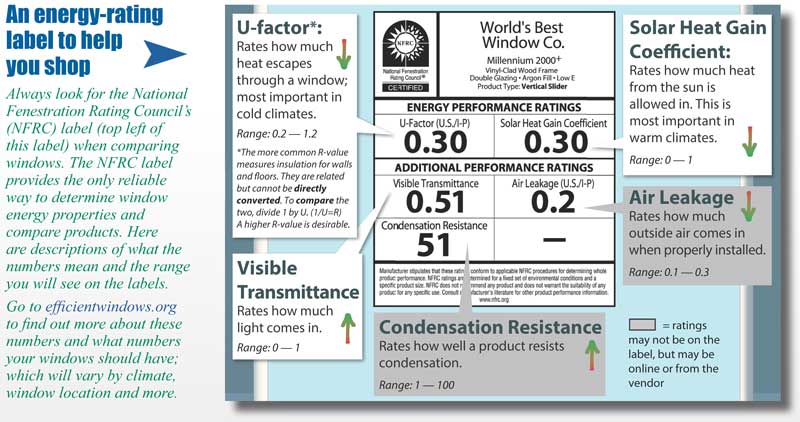How Much Can Energy-efficient Windows Save You?
For those who ask, “Can energy-efficient windows save me money?” the answer is “Yes!” According to the Department of Energy, windows are 25 to 30 percent responsible for the amount of energy you use to heat and cool your home. That equates to anywhere from $125 to $465 savings per year. As a result, taking the time to replace old windows in your home with new, more energy-efficient windows is a great way to start saving money on your utility bills.
That being said, there are other, less expensive options to improve your home’s energy efficiency. Learn more about low-cost energy-saving ideas here.
HOW OFTEN SHOULD YOU REPLACE RESIDENTIAL WINDOWS?
Most window installers and professionals recommend that homeowners replace their windows every 15 to 20 years. However, a home energy audit can help determine if you truly need new windows. If you decide to buy replacement windows, look for the ENERGY STAR® label. When energy-saving windows are properly selected and installed, they can help minimize your heating, cooling and lighting costs.
TYPES OF ENERGY-EFFICIENT WINDOWS
Choosing the most energy-efficient windows for your home depends on the window style, frame, glass type and energy performance ratings. Below, we’ll discuss the benefits and drawbacks of different types of replacement windows. With this information, you will be equipped to buy the best energy-efficient windows for your home.
WINDOW FRAME MATERIALS
Some of the most common and efficient window frame types are wood, vinyl and fiberglass.
WOOD WINDOW FRAMES
Wood window frames insulate well, but expand and contract when weather conditions change. They also require regular maintenance for appearance and energy efficiency.
VINYL WINDOW FRAMES
Vinyl window frames offer various benefits. They are energy-efficient and virtually maintenance-free. They do not require painting and have good moisture resistance. The hollow cavities of vinyl frames can be filled with insulation, which makes them superior in efficiency to standard vinyl and wood frames.
FIBERGLASS WINDOW FRAMES
Fiberglass window frames are extremely strong and have air cavities that can be filled with insulation, giving them superior energy efficiency compared to wood or uninsulated vinyl. They can be painted any color to match interior or exterior house colors. Fiberglass frames also expand and contract with temperature changes.
WINDOW STYLES
Some types of replacement residential windows come with the benefit of having lower air leakage rates because of operating type. Below, we’ll discuss six main styles of replacement windows and which ones are best in terms of energy-efficiency.
AWNING
Awning windows are hinged at the top and open outward. Since they close by pressing against the frame, they generally have lower air leakage rates, making them more energy-efficient compared to sliding windows.
CASEMENT
Casement windows are hinged at the sides. Like awning windows, they generally have lower air leakage rates and are more energy-efficient than sliding windows.
FIXED
Fixed window panes don’t open. When installed properly they’re airtight, making them one of the most energy-efficient options on the market.
HOPPER
Hopper windows are hinged at the bottom and open inward. Like awning and casement, they generally have lower air leakage rates.
SINGLE AND DOUBLE-HUNG
Single and double-hung windows slide vertically to open and close. They generally have higher air leakage rates and are less energy-efficient than hinged windows.
SINGLE AND DOUBLE-SLIDING
Single and double-sliding windows slide horizontally to open and close. Like single- and double-hung windows, they generally have higher air leakage rates and are less energy-efficient than hinged windows.
WINDOW GLASS AND ENERGY EFFICIENCY
Some elements of glass that improve energy-efficiency include gas fills, insulated window glazing and low-emissivity coatings.
GAS-FILLED WINDOWS
Gas fills improve energy-efficiency by filling the space between the panes with inert gas, which has a higher resistance to heat flow than air does. Gas fills are used to make double- and triple-pane windows more energy-efficient.
INSULATED WINDOW GLAZING
Insulated window glazing refers to double- or triple-paned glass. To insulate the window, the glass panes are spaced apart and sealed, leaving an insulating air space.
LOW-E COATINGS
Low-emissivity, also known as low-e coatings control heat transfer through windows with insulated glazing. A low-e coating is a thin, virtually invisible metal layer on the surface of one or more of the panes of glass.
All three of these glass types lower a window’s energy-efficiency rating or u-factor, which is the rate of heat loss in a window.
HOW TO INSTALL ENERGY-EFFICIENT WINDOWS IN YOUR HOME
It’s essential when replacing old windows in your home, you install your new energy-efficient windows properly. If you do so, you can achieve optimal window performance and avoid water leakage. Here are a few things to keep in mind when installing new windows in your home:
- Always follow your window manufacturers’ guidelines
- Hire trained professionals to install your new windows
- Be sure your windows are correctly air-sealed during installation
- When air-sealing windows, caulk the frame and weatherstrip operable components

